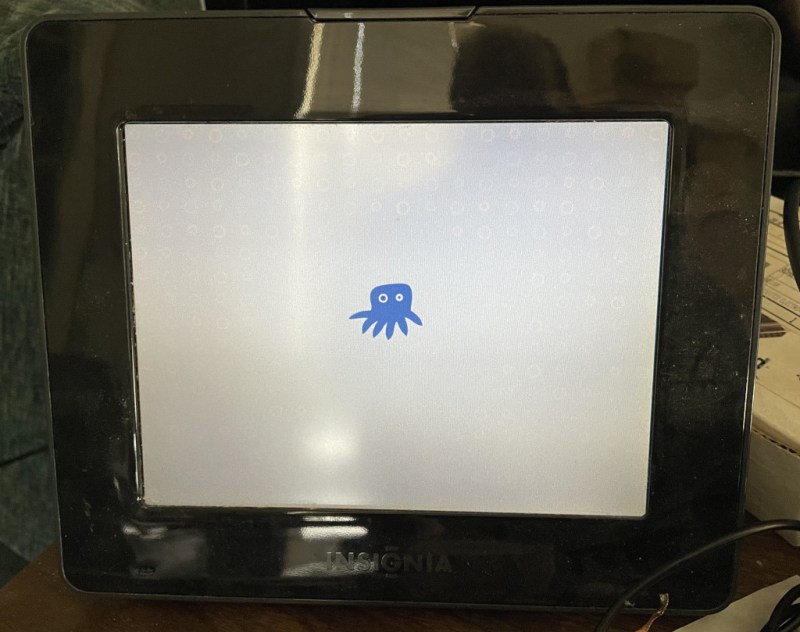It has been two years, but the slow and steady progress that [Doug Brown] has been making towards bringing a modern Linux kernel to the Chumby has approached the point that it could be called done. In his final blog post of the series, [Doug] walks through the highs and lows of the whole process.
Many of the changes [Doug] and others have made are already upstream in the Linux mainline. However, some will likely remain in private branches for a few reasons that [Doug] gets into. The blog post covers every commit needed to turn a Chumby or other Marvell ARMADA-powered widget into a working device. At the end of the day, what does [Doug] have to show? He can turn it on, see a boot logo, and then see an indefinite white screen. While underwhelming to most of the world, an X server is coming up, Wi-fi is online, the time syncs from an NTP server, and the touchscreen is ready to be tapped. A white screen, yes, but a white screen of potential. [Doug] has to decide what to launch after boot.
However, the future of the Chumby and other older devices is still on the chopping block of progress. Compiler writers want to drop support for platforms that nobody uses anymore, and the Chumby is ARMv5. With many changes destined to languish, [Doug] still considers it a huge success, and we do too. The whole series represents a journey with beautiful lessons about the power of the Linux device tree, making the dark and scary world of Linux kernel drivers seem a little more approachable.
We’ve covered the first post and when graphics started coming along. We salute the mighty Chumby and the idea it stood for. Of course, the idea of a handy screen displaying information is still alive and well. This handy e-paper HomeAssistant display is just one of many examples.















Whatever it is, it should have an LCARS interface.
Make it so…
heh for a brief moment 20 years ago i was running in this direction
https://galexander.org/gglcars/
@RunnerPack said: “Whatever it is, it should have an LCARS interface.”
Put LCARS on it and see how long it takes before CBS Television Studios sues you.[1]
CBS Television Studios claims to hold the copyright on LCARS.
https://en.wikipedia.org/wiki/LCARS#Legal
Be nice if the kernel developers could come up with a way to keep legacy gear functional, or document a path. I suppose LFS is an option as long as old versions of the source can be located.
You are thinking of buildroot! :)
It has everything from early kernels to the most modern, and creates a similar root system like LFS.
SUPER easy to use too!
FYI:
https://en.wikipedia.org/wiki/Chumby
Thanks so much Doug!
Into a working device? Mine still works fine as an alarm clock.
> He can turn it on, see a boot logo, and then see an indefinite white screen.
I’m reminded of a talk by Christian Joudrey about learning to write NES games in Assembly, and the excitement of getting to a point of explicitly showing a background “No, it’s not a blank screen – it’s a *black* screen” (https://youtu.be/kXbMCKMJXXQ)
Sometimes those early milestones don’t truly describe the accomplishment.
i am of the belief that legacy hardware runs best with legacy software. you can still download gcc 2.95 and linux 2.x, and everything in between. it’s not really that hard to seriously use it either, with virtualization where it is. my only frustration with my ancient kernels is no wireguard, but legacy openvpn* still works. not sure what they’re trying to accomplish but what i want is a modern chumby hardware. tbh, i’m pretty vexed that worn out cellphones and tablets don’t survive well left on a charger 24/7.
* openvpn is moving towards banning their legacy pre-shared key authentication and forcing TLS, which will make that less certain
https://www.reddit.com/r/calvinandhobbes/comments/6pig9h/honestly_knowing_this_one_was_the_last_calvin_and/#lightbox
I loved my OG chumby!!!
Where is Andrew “Bunnie” Huang?[1]
1 – https://en.wikipedia.org/wiki/Andrew_Huang_(hacker)